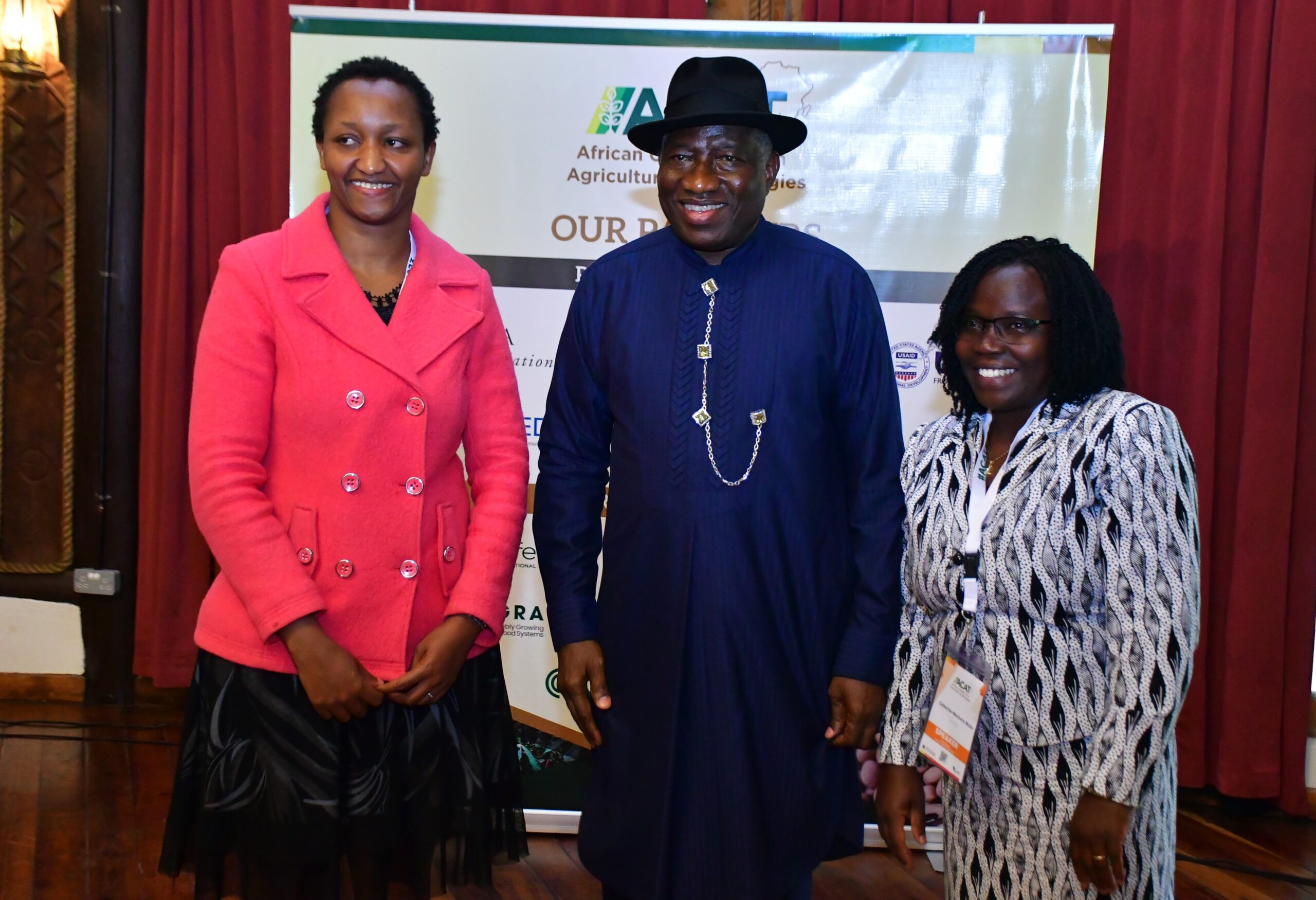
In addition to their work supporting African agricultural institutions in mainstreaming gender and integrating nutrition, the staff of Tanager’s Impacting Gender & Nutrition through Innovative Technical Exchange in Agriculture (IGNITE) project spent much of 2023 sharing their learnings at development conferences around the world. Among the events capping off this busy year of knowledge exchange: the inaugural African Conference on Agricultural Technologies (ACAT), hosted by IGNITE client, African Agricultural Technology Foundation (AATF).
ACAT gathered businesses, scientists, development practitioners, and policymakers in Nairobi, Kenya, in early November to exchange ideas and explore solutions to enhance agricultural productivity in Africa. Themed “Agricultural Resilience through Innovation,” the ACAT platform aligned with Tanager’s work of addressing poverty, malnutrition, and gender equality in the agricultural sector. Three Tanager representatives from the IGNITE project, in fact, featured prominently with panel and keynote speaking appearances during the five-day conference. They spoke on a range of topics related to gender equity, social inclusion, and nutrition.
How Can Institutions Cultivate Inclusivity?
Dr. Mary Thamari, IGNITE gender expert, served as one of the panelists during a gender dialogue panel on cultivating inclusivity. From Tanager’s experience strengthening gender capacity among institutions, she reflected that the stickiest problems around gender and inclusivity are:
- Limited representation in decision making at the household, community, and policy levels. “If women are not at the table of decision-making, then their needs and interests remain unknown and therefore unaddressed in agriculture technology adoption,” Thamari said.
- Insecure land tenure rights. According to Thamari, tension between customary land laws and statutory laws discourage long-term investments in agriculture technologies. In most cases the customary land laws give men rights over land while statutory laws encourage equality in land ownership. Enforcing equal land rights is difficult, especially for women, and consequently they cannot lay claims that would enable them to invest in the land. This slows or limits technology adoption.
To begin addressing these issues, organizations need to position the business case for gender and inclusion—and, on the flip side, catalogue the business or revenue losses that come from exclusion and gender inequality. Thamari pointed out that, per 2023 World Bank data, women perform more than 40% of the labor work in Africa’s agriculture sector yet continue to be disempowered by their limited access to productive resources such as land, inputs, credits, and extension services. She referenced a UN Food and Agriculture Organization data point that farm yields could increase by 20% to 30% if women had access to these resources—which would also result in better health, nutrition, and education across populations.

“The productivity of women in agriculture could tilt the scales in food security and secure livelihoods for communities,” Thamari said.
Thamari suggested several other approaches to accelerate gender and inclusion within agricultural institutions:
- Because gender-equal and inclusive governance boards and management teams lead to greater corporate transparency and improved ethical orientation, organizations must push for gender diversity on boards.
- Gendered support networks and mentorship create opportunities for moving inclusion forward: Gendered peer learning and support networks, for example, allow farmers to discuss challenges and seek collective solutions. Agriculture experts and women who have succeeded in technology adoption, meanwhile, can mentor others and help troubleshoot the technology adoption process.
- Institutions should seek greater collaboration with stakeholders—for example, research institutions—where the same language and goals are being advanced. Collaboration provides a supportive ecosystem in which to build a holistic support system for women entrepreneurs in agriculture, says Thamari.
- Many agree on the need for leadership buy-in, but “leadership buy-in” also means having institutional commitments to gender, equity, and inclusion from a governance standpoint. “Policies make clear the organizational commitments to gender equality and social inclusion. These cascade further into organizational and programmatic strategies and processes, and this is where gender strategies and action plans need to be drawn,” explains Thamari.
Opportunities to Leverage Digital for Nutrition Education
Meanwhile, IGNITE Deputy Team Leader Dr. Catherine Macharia-Mutie participated in a panel on nutrition-sensitive agriculture.
“Here’s what we know,” Macharia-Mutie began, observing how COVID-19 accelerated the advancement and broad acceptance of technology. While a “digital divide” does exist in terms of who owns desktop or laptop computers and who enjoys home broadband internet access, she pointed out that many people—across income, race/ethnicity, and age—now own smartphones and use social media. A UN Standing Committee on Nutrition published a report in 2020, “Nutrition in a Digital World,” had further noted that digital tools can help transform food systems.

Meanwhile, Macharia-Mutie noted, that nutrition education is a critical component of nutrition-sensitive agriculture. Given this, she queried, how can digital tools and innovation be used to enhance nutrition awareness and education among farmers and communities? She offered several considerations:
- While ag tech innovations such as tools for post-harvest management often come to mind when talking about agricultural technology, digital technologies for behavior change communications are what could be called “soft” innovations in this sector
- Digital tools and innovations must consider different audiences—such as women and youth—when designing their content, character, and reach
- E-modules for frontline agriculture staff in institutions are helpful in increasing their awareness and intentionality in communicating with farmers. IGNITE, for example, supported one of its clients, Solidaridad East and Central Africa, develop nutrition-sensitive agriculture e-modules on its “Jifunze” eLearning platform to boost the institution’s effort in integrating nutrition into its programmatic activities.
- Institutions should be prepared to use different channels, depending on their goals. These include Interactive Voice Response (IVR), mobile short service messaging, messaging via WhatsApp, talking radios, mobile apps such as the OFSP app in Uganda by Harvest Plus, and community videos. IGNITE conducted a study on behalf of Digital Green under the Digital Agricultural Advisory Services (DAAS) project to determine the impact of IVR messages on dairy farming. Farmers receive informative audio messages on various dairy practices, such as artificial insemination services, cow and calf management, improved husbandry practices, and improved feed and feeding. The study found that these informative messages have helped many farmers increase their agricultural productivity.
Gender Key to Nutrition-Sensitive Agriculture
Finally, Tanager’s Kenya Country Representative Maureen Munjua delivered a keynote address that wrapped in both gender and nutrition elements. Following a panel discussion on what stakeholders need to scale up nutrition-sensitive agriculture, Munjua underscored that nutrition-sensitive agriculture is key to the production and consumption of diverse and nutritious foods for improved nutrition outcomes. And, as panelists had noted during the discussion, gender is key to nutrition-sensitive agriculture.

“Promote gender inclusivity, from research to implementation,” Munjua said.
The IGNITE team lead added the following points:
- To scale up nutrition-sensitive agriculture and contribute to sustainable development goals, institutions should harness the benefits of research.
- Organizations must adopt a multi-disciplinary and multi-sectoral approach to reach nutrition outcomes. A good starting point would be to define shared goals, values, and commitments for integration and collaboration, Munjua suggested.
- Leveraging partnerships also help with maximizing resources and allow institutions to hold one another accountable.
Munjua advised that institutions invest in nutrition training and capacity building. Most of all, she insisted, “Invest in scaling up nutrition, because nutrition is a matter of dignity.”


